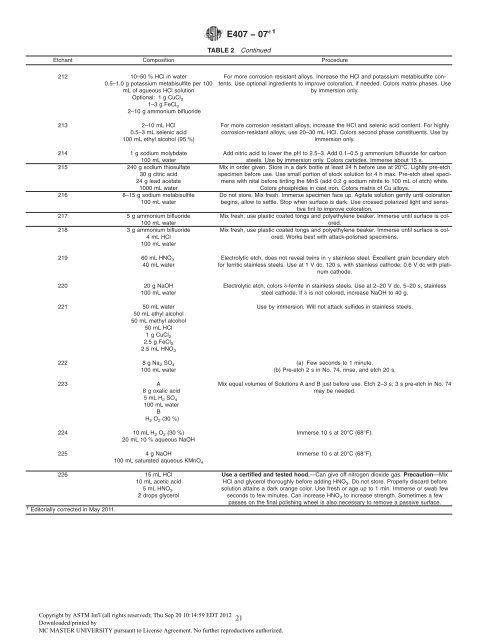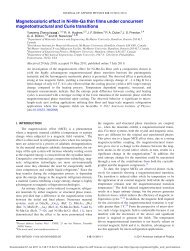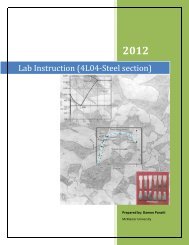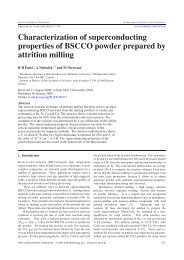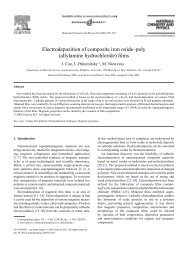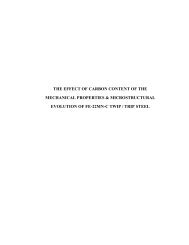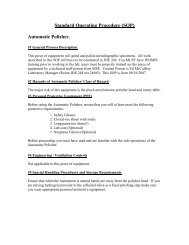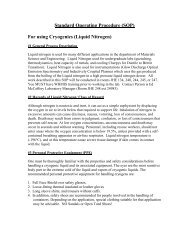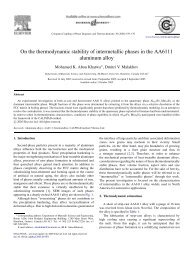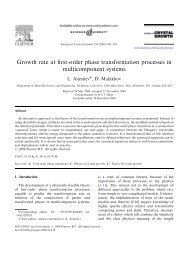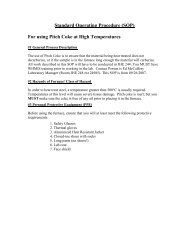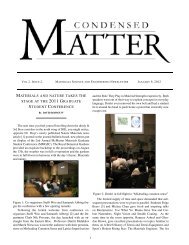E407-07 Microetching Metals and Alloys.pdf - McMaster Department ...
E407-07 Microetching Metals and Alloys.pdf - McMaster Department ...
E407-07 Microetching Metals and Alloys.pdf - McMaster Department ...
You also want an ePaper? Increase the reach of your titles
YUMPU automatically turns print PDFs into web optimized ePapers that Google loves.
TABLE 2 Continued<br />
Etchant Composition Procedure<br />
212 10–50 % HCl in water<br />
0.5–1.0 g potassium metabisulfite per 100<br />
mL of aqueous HCl solution<br />
Optional: 1 g CuCl 2<br />
1–3 g FeCl 3<br />
2–10 g ammonium bifluoride<br />
213 2–10 mL HCl<br />
0.5–3 mL selenic acid<br />
100 mL ethyl alcohol (95 %)<br />
214 1 g sodium molybdate<br />
100 mL water<br />
215 240 g sodium thiosulfate<br />
30 g citric acid<br />
24 g lead acetate<br />
1000 mL water<br />
216 8–15 g sodium metabisulfite<br />
100 mL water<br />
217 5 g ammonium bifluoride<br />
100 mL water<br />
218 3 g ammonium bifluoride<br />
4 mL HCl<br />
100 mL water<br />
219 60 mL HNO 3<br />
40 mL water<br />
220 20 g NaOH<br />
100 mL water<br />
For more corrosion resistant alloys. Increase the HCl <strong>and</strong> potassium metabisulfite contents.<br />
Use optional ingredients to improve coloration, if needed. Colors matrix phases. Use<br />
by immersion only.<br />
For more corrosion resistant alloys, increase the HCl <strong>and</strong> selenic acid content. For highly<br />
corrosion-resistant alloys, use 20–30 mL HCl. Colors second phase constituents. Use by<br />
immersion only.<br />
Add nitric acid to lower the pH to 2.5–3. Add 0.1–0.5 g ammonium bifluoride for carbon<br />
steels. Use by immersion only. Colors carbides. Immerse about 15 s.<br />
Mix in order given. Store in a dark bottle at least 24 h before use at 20°C. Lightly pre-etch<br />
specimen before use. Use small portion of stock solution for 4 h max. Pre-etch steel specimens<br />
with nital before tinting the MnS (add 0.2 g sodium nitrite to 100 mL of etch) white.<br />
Colors phosphides in cast iron. Colors matrix of Cu alloys.<br />
Do not store. Mix fresh. Immerse specimen face up. Agitate solution gently until coloration<br />
begins, allow to settle. Stop when surface is dark. Use crossed polarized light <strong>and</strong> sensitive<br />
tint to improve coloration.<br />
Mix fresh, use plastic coated tongs <strong>and</strong> polyethylene beaker. Immerse until surface is colored.<br />
Mix fresh, use plastic coated tongs <strong>and</strong> polyethylene beaker. Immerse until surface is colored.<br />
Works best with attack-polished specimens.<br />
Electrolytic etch, does not reveal twins in g stainless steel. Excellent grain boundary etch<br />
for ferritic stainless steels. Use at 1 V dc, 120 s, with stainless cathode; 0.6 V dc with platinum<br />
cathode.<br />
Electrolytic etch, colors d-ferrite in stainless steels. Use at 2–20 V dc, 5–20 s, stainless<br />
steel cathode. If d is not colored, increase NaOH to 40 g.<br />
221 50 mL water Use by immersion. Will not attack sulfides in stainless steels.<br />
50 mL ethyl alcohol<br />
50 mL methyl alcohol<br />
50 mL HCl<br />
1 g CuCl 2<br />
2.5 g FeCl 3<br />
2.5 mL HNO 3<br />
222 8 g Na 2 SO 4 (a) Few seconds to 1 minute.<br />
100mLwater (b)Pre-etch2sinNo.74,rinse, <strong>and</strong> etch 20 s.<br />
223 A<br />
8 g oxalic acid<br />
5mLH 2 SO 4<br />
100 mL water<br />
B<br />
H 2 O 2 (30 %)<br />
224 10 mL H 2 O 2 (30 %)<br />
20 mL 10 % aqueous NaOH<br />
225 4 g NaOH<br />
100 mL saturated aqueous KMnO 4<br />
226 15 mL HCl<br />
10 mL acetic acid<br />
5 mL HNO 3<br />
2 drops glycerol<br />
† Editorially corrected in May 2011.<br />
<strong>E4<strong>07</strong></strong> − <strong>07</strong> ´1<br />
Copyright by ASTM Int'l (all rights reserved); Thu Sep 20 10:14:59 EDT 2012<br />
21<br />
Downloaded/printed by<br />
MC MASTER UNIVERSITY pursuant to License Agreement. No further reproductions authorized.<br />
Mix equal volumes of Solutions A <strong>and</strong> B just before use. Etch 2–3 s; 3 s pre-etch in No. 74<br />
may be needed.<br />
Immerse 10 s at 20°C (68°F).<br />
Immerse 10 s at 20°C (68°F).<br />
Use a certified <strong>and</strong> tested hood.—Can give off nitrogen dioxide gas. Precaution—Mix<br />
HCl <strong>and</strong> glycerol thoroughly before adding HNO 3. Do not store. Properly discard before<br />
solution attains a dark orange color. Use fresh or age up to 1 min. Immerse or swab few<br />
seconds to few minutes. Can increase HNO 3 to increase strength. Sometimes a few<br />
passes on the final polishing wheel is also necessary to remove a passive surface.


